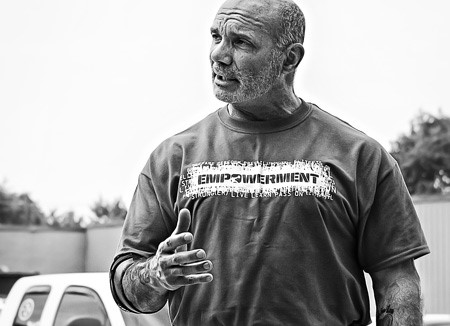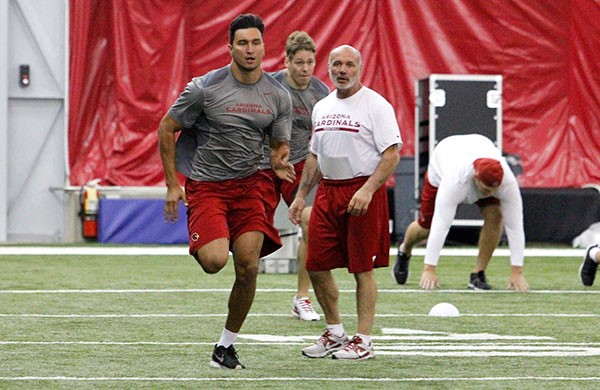
This fitness industry is growing and changing so rapidly that many coaches will be left behind if they don’t continue to surround themselves with new people and new ideas.That’s why in The Smartest Coach in the Room, I talk with a wide variety of experts from the fitness, sport, and performance industry about the profession they’ve dedicated their lives to — and the tips, tactics, and trade secrets they’ve used to get to the top of their field.
Buddy Morris: Strong opinions from 38 years of strength and conditioning
Buddy Morris is a 38-year strength and conditioning veteran who is currently the Head Strength & Conditioning Coach for the Arizona Cardinals.
In the latest installment of The Smartest Coach in the Room, I talk with Buddy about programming, punching social media fitness “experts”, and what it takes to become a coach at the highest level of sport.
Listen to the full podcast conversation below — and check out the conversation highlights below that.
Highlights and quotables from Buddy Morris
It’s nice to be around people who are not “status quo.” The people who aren’t afraid to create a little anarchy.
I think social media is the worst thing in this world. I got sent an Instagram thing and there was this kid that goes flying through this foot ladder, like Guitar Hero but with feet. At first, it was funny. I was laughing my ass off. Then I get to the point where I’m like, “Now I’m getting irritated, because this is what people believe is training.” I had to delete it from my phone. That doesn’t transfer to true speed. That does not transfer to true acceleration work. I wanted to punch the kid. With all due respect.
When was the last time you saw a Dan Pfaff or the late, great Charlie Francis, or Al Vermeil, or any of these great speed coaches pull out a foot ladder and talk about speed improvement? I’ve got this hate-on for the foot ladder and people who use it. I really do. It just drives me…you know, don’t waste my time.
People wanna be gurus, Joel. They wanna be that guy. We’re in a fitness-crazed society that’s always looking for the newest, latest, greatest, cutting edge. And there is nothing new, there is nothing great, there is nothing cutting-edge. It’s just very basic and simplistic. Look at all the great coaches and what they have done. They have been very basic, very simplistic, and they understand the body’s accommodating response to the stressors imposed upon them.

What really got me into lifting was a guy named Harvey Glance, back in 1978. He was this great sprinter from Auburn who had benched 350 pounds. I put two and two together and thought, “OK, if lifting weights makes me stronger, then it’s gonna make me faster too.”
1980, University of Pittsburgh. I’d been on a track scholarship as a short sprinter and long jumper. My junior year, I decided I had enough of college athletics and asked permission to use the football players’ weight room. I started helping head coach Jackie Sherrill and his athletes with the 40-yard dash start as they got ready for the NFL draft.
There was no [NFL] combine back in the day. Scouts would just call the university and say, “Hey, I’m gonna be in tomorrow to work out so-and-so.” So you could have three and four workouts in a week, and everybody was all over the place. There was no organization. The first day of camp, all hell breaks loose.
I know this is blasphemy, but our skill guys don’t squat during fall camp. Their hamstrings are already bearing a tremendous force eccentrically from the acceleration and deceleration. Think about the position of a load on the bar and a squat. What prevents the pelvis from dropping out with a load on your shoulders is obviously the hamstrings, which have already been abused from multiple route running, multiple change of direction, multiple accelerations in short periods of time.
So they [the skill guys] do all-concentric trap bar pulls. I learned that from Ryan Flaherty. I brought him to the last two camps to make him tell me what we were doing wrong. All of our glute work is static now. So it’s some activation work, and they’re out the door.
Remember this: any athlete who doesn’t have to practice will get stronger two to three times faster than an athlete who has to practice. Ask any great powerlifter, any great Olympic lifter, ask ’em this, “Can you compete at the highest level of your sport every weekend for 22 weeks straight?” And then see what they say. But that’s what we have to do in professional athletics.
Your program is a living, breathing organism. It has to adapt to every different circumstance and environment. I hate when people say, “Progressive overload.” It’s not progressive overload. Even in Supertraining, it says, “Fluctuating overload,” which is the ability to handle where your readiness is for the day.
Don’t do something just because it’s written on paper for the day. As you watch your athletes move, you watch them dynamically warm up, they’ll tell you. Their bodies will talk to you.

Case in point: We had about three weeks left of the season and Carson Palmer [quarterback for the Arizona Cardinals] came into lift one day. I said, “Carson, how are you feeling?” He said, “I feel great.” I said, “Really? Because your posture and your eyes tell me something different.”
So I just put it out there and said, “Here’s what we’re gonna do for the day. We’re going in the pool, we’re doing some recovery work, we’re doing some low-intensive work in the weight room with bands and medicine balls to promote a circulatory response. We’re gonna promote recovery through low-intensive work.” We did that for about 30 minutes. He came back the next day and says, “I feel unbelievable.” I gave him what he needed, not what he wanted.

One of the best ways to assess your athletes is when you get ’em all together. If they’re a bunch of chatty cats, like a bunch of old women that can’t shut up, they’re ready to go. But if they’re all just laying on the foam roller, with a dead-eyed look, no music or sound, you’d better be able to change and adapt your program.
[Sprint coach] Charlie Francis said it best: “Coaches are incredibly innovative in screwing up training.” They really are.
I feel very fortunate to be in the right place at the right time and have the opportunity to train these guys. But at the same time, Joel, I’m not gonna let them down. They rely on me, and I’m not gonna betray anybody’s trust or anybody’s reliance on me. It’s my job to help them get there.
How Are You Becoming the Smartest Coach in the Room?
If there’s one trait that all great coaches have, it’s this: They’re constantly striving to be better than the day before. Whenever they find that they’re the smartest person in the room, they pick a different room to stand in, and find new people to learn from.
That’s how you grow your business. That’s how you get better results with your clients. That’s how you build a career that lasts.
So my question to you is this: Who are you learning from — and how are you using that information to become better?

Great conversation! I have a question that fits into the guru-squat-37-years-training axis. I’m 45, primary sport is BJJ, but still squat heavy (495lbs, 4×5) once a week, because I found that when I stopped, my back started to hurt from sitting at the computer 10 hours a day.
I recently took a seminar with a well-respected BJJ/mobility “guru” who insisted I’d be a cripple by 55 if I kept up the squats, and became almost hostile when I told him that they helped my back. I’ve been a fan of 8weeksout since almost the beginning, but haven’t seen many articles for the aging athlete. Do you think there’s any wisdom in the suggestion that older athletes shouldn’t squat? Thank you!